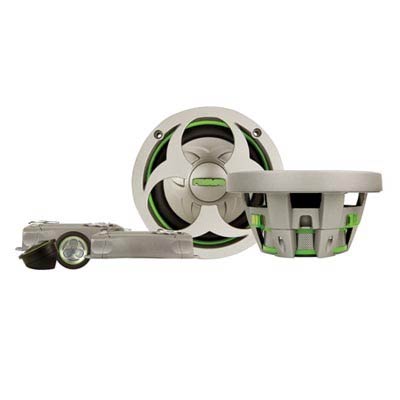Fusion NV-CM65
A two-way component speaker system with separate tweeter units, midbass drivers and passive crossovers. Complete with a mounting kit to fit the tweeters in more than one application, wires, stickers, gaskets, Allen key and screws and fixings. The paper coned midbass drivers are heavily built and have their tinsel wires actually woven into their spider suspensions which is a high power handling feature and stops these from flapping under a violently moving cone. Oddly, the mids also have one of the most fiddly and small aperture speaker wire fixing points in the group, which seems to contradict woven tinsels. A sized-down bootlace crimp would enable you to use a thicker wire with this terminal, though.
The Butterworth design passive crossovers are very straightforward in appearance but far from it in operation as they use staggered frequency points. The highs are filtered to have less and less from 3.5kHz and down while the lows are not filtered in the opposite direction from the same frequency point but rather from 4.5kHz, leaving a whole thousand cycles of overlap frequency-wise. This is probably about stopping holes in the output while letting the drivers’ own roll off be part of the party I feel. The tweeters are Titanium dome designs again all about a high power output.
The midbass drivers are very weighty and feel serious in the hand when fitting.
– Power Handling 80w RMS
– Sensitivity 92dB 1w/1M
– Own Pink noise test figure 116.7dB (Vol @20 @ trk 9 dB Drag Vol III)
– Passband 50Hz to 23kHz
– Tweeter diameter 51mm
– Tweeter Mounting Depth 30mm
– Midbass Mounting Depth 64mm
– Cone: formed paper pulp
– Tweeter: Titanium dome
– Crossover slope & point: 12dB per octave @ 3.5kHz HPF & 4.5kHz LPF (Butterworth)
– Chassis: die cast Aluminium
– Complete with: Wires, fixings, stickers, gasketing, tweeters mounting kits, Allen key, paper templates
Review by Adam Rayner
My notes say somewhat irreverently ‘Big sound with bollocks!’ (It’s alright: Since The case of Sex Pistols vs. Regina the words ‘bollocks’ was declared not obscene in the high court – have that fact for Christmas!) Despite what appear to be triumphs of meaty design flavour over sensible compactness – they do seem to be mostly space inside – they work well and the drivers are what’s causing the excitement. They haven’t got the midband clarity of the Rainbows ( a tenner more) but they do have a huge low end response. With all the power I had on tap from the guts of the Odyssey PC925 and the iPaul amplifier dumping well over a ton in watts up each bridged speaker wire, the Fusions just ate it up and loved it.
The other staggering thing was that while they really took a large amount of power before sounding at all stressed, which they do eventually in my rig, they are also the most mind bendingly efficient things in all twenty sets. I did the same track 9 test at 20 volume on the test deck. I had the mic-on-a-tripod and the box in the same place butted firmly against the wall and the rest of the rig. I had the AudioControl SA-3055 RTA set to spl and it measured a nutty 116.7dB. This is a clear 4.7dB louder than the least efficient in the twenty strong group, which is mad. OK, the Pioneers sacrifice efficiency for high end excellence, but these say ‘Lets party Kiwi style ’till the Strines all drop’. They are so loud and powerful it was madness.
You could feel the bass in your chest on heavy notes and although less than prim, these are one hell of a choice for the person who can only buy the once but wants smacking potency on headunit power, then the ability to rock on a decent amount of amp power later. Incredible installation flexibility then, vis-a-vis how many watts you got.
Overall 8.4
Sound Quality 7
Build Quality 8
Power Handling 9
Efficiency 10
Value For Money 8

